What about the natural occurrence of larch in the Czech Republic
The concept of origin in population biology is problematic because it is based on fragmentary historical data. A typical example is the still unsolved problem of the natural occurrence of European larch in the territory of today’s Czech Republic, which has been discussed among foresters and botanists for almost a century.
Unexpectedly interesting information was published by scientists in the article “New paleobotanical data prove the native status of European larch in North Bohemia“ /„Nová paleobotanická data prokazují původní status modřínu opadavého v severních Čechách“, which was issued in the journal Reports of Forestry Research 4/2023. The article was created with the support of the NAZV project QK21010335 – “Possibilities of using deciduous larch in Czech forests under the impact of GKZ” (LARIXUTOR). The authors of the article are Petr Pokorný, Kristýna Hošková, Jindřich Prach, Charles University; Petr Šída, University of Hradec Králové; Pavel Bednář, VÚLHM, v. v. i., VS Opočno /FGRMI, Research Station Opočno).
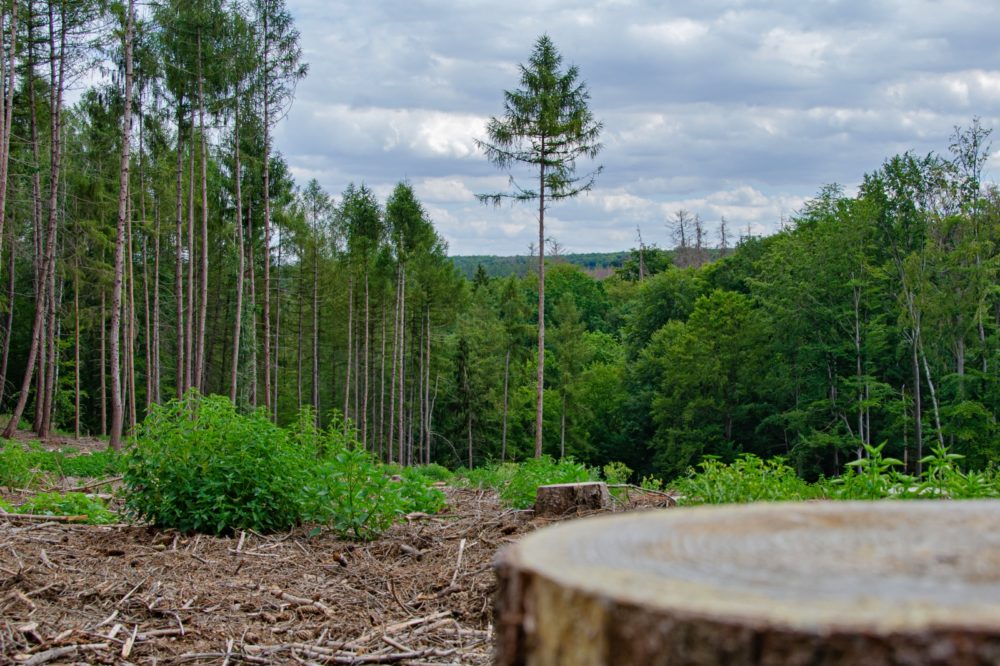 Photo: Reserved tree of European larch on the clearcut area
Photo: Reserved tree of European larch on the clearcut area
During the middle holocene and the beginning of the younger holocene (7000-3000 years ago), the Central European larch was forced to retreat to the high altitudes of the Alps and the Western Carpathians due to the expansion of deciduous trees. Currently, the Central European range of the European larch is highly disjoint and it is not expected to occur naturally in the historical territory of Bohemia. The main centre of occurrence of larch is undoubtedly in the Alps. Historical sources indicate that most of our larch trees were planted artificially during the modern era, with the exception of the locations in Bruntál and Jeseníky Mts. areas where they occur naturally.
It is quite challenging to find paleobotanical records that provide information on the past presence of European larch. This is because microscopic anatomical wood structures, such as those found in spruce trees, can be easily confused with those of E. larch. Additionally, the production of plant opals – phytoliths, and pollen grains, which are used for identification, is very low, making it even more difficult to obtain accurate data.
Scientists working on the LARIXUTOR project (https://www.poznejmodrin.cz/) discovered that the most suitable terrain for paleobotanical research is located in the North Bohemian sandstone areas, specifically in the Bohemian Paradise (Český ráj) and in Bohemian Switzerland (České Švýcarsko, Elbe Sandstones). These areas have exposed rock habitats that are in close proximity to wetlands, which offer uninterrupted peat records containing well-preserved plant remains. The researchers were able to obtain positive results in four cases:
(1) Scientists have discovered pollen grains of larch at the Otto Mörtsche Cave site (Jeskyně Otto Mörtsche). The cave is located on the edge of the Elbe canyon above the village of Hřensko. The pollen grains were found in a rock gap and were dated using radiocarbon dating. The pollen grains come from the early Holocene period and also from the critical period of the middle Holocene. This is an important finding because larch pollen grains are found here in the middle Holocene in layers dominated by deciduous trees, especially with common hazel and linden tree species. This confirms not only the dating to the middle Holocene but also the extraordinary importance of rocky habitats for the survival of European larch.
(2) The Ocher overhang in “Pravčický důl” locality is the second newly discovered site where prehistoric larch pollen grains have been found in Bohemian Switzerland (České Švýcarsko). Although the research of this archaeological site is ongoing and will take many more years, the scientists have published their preliminary findings in an article that is already fully conclusive today.
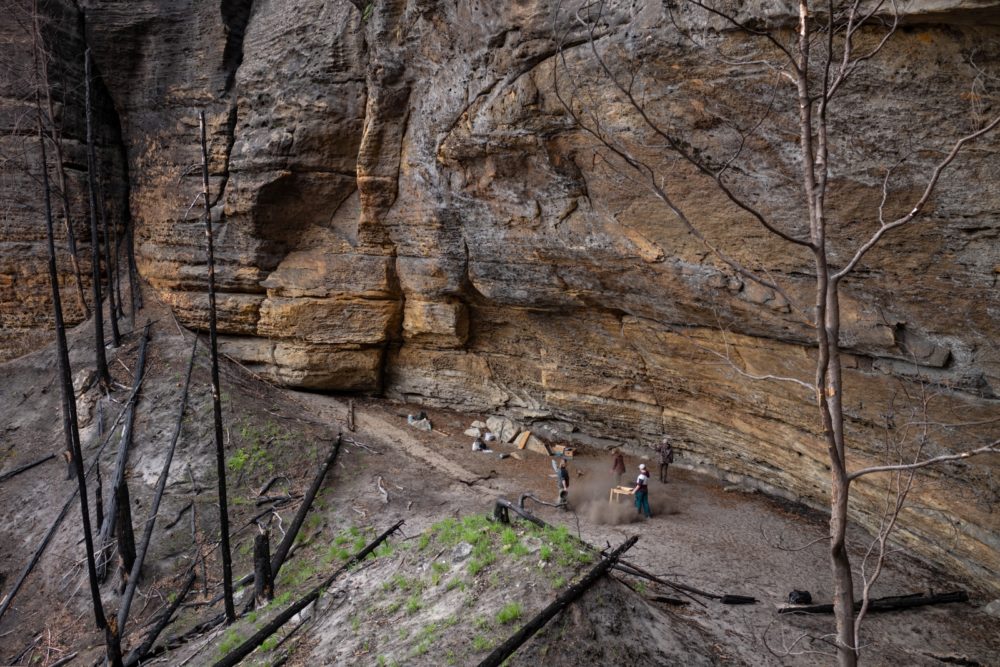 Photo: Ocher overhang in “Pravčický důl” in České Švýcarsko National Park at the beginning of the research in May 2023, organic remains are perfectly preserved in the powerful sedimentary sequence under the massive, south-facing overhang; author P. Pokorný
Photo: Ocher overhang in “Pravčický důl” in České Švýcarsko National Park at the beginning of the research in May 2023, organic remains are perfectly preserved in the powerful sedimentary sequence under the massive, south-facing overhang; author P. Pokorný
(3) In the “Maják” peat deposit of the “Čertova ruka” rock area in Český ráj, scientists have discovered a continuous presence of larch pollen grains throughout the middle and younger Holocene. These grains were found in a location directly beneath the exposed rock walls, and were present during a time when hazel, linden, and oaks were the dominant trees, as well as during a subsequent period when the tree vegetation was dominated by beech and silver fir. It should be noted that the larch pollen curve is not closed, indicating a relatively rare but continuous occurrence of this pollen type, despite the low pollen production of European larch.
(4) In the Velký Mamuťák area of Český ráj, animal dung analysis revealed the presence of larch during the Iron Age and early middle Ages, under a large sandstone overhang.
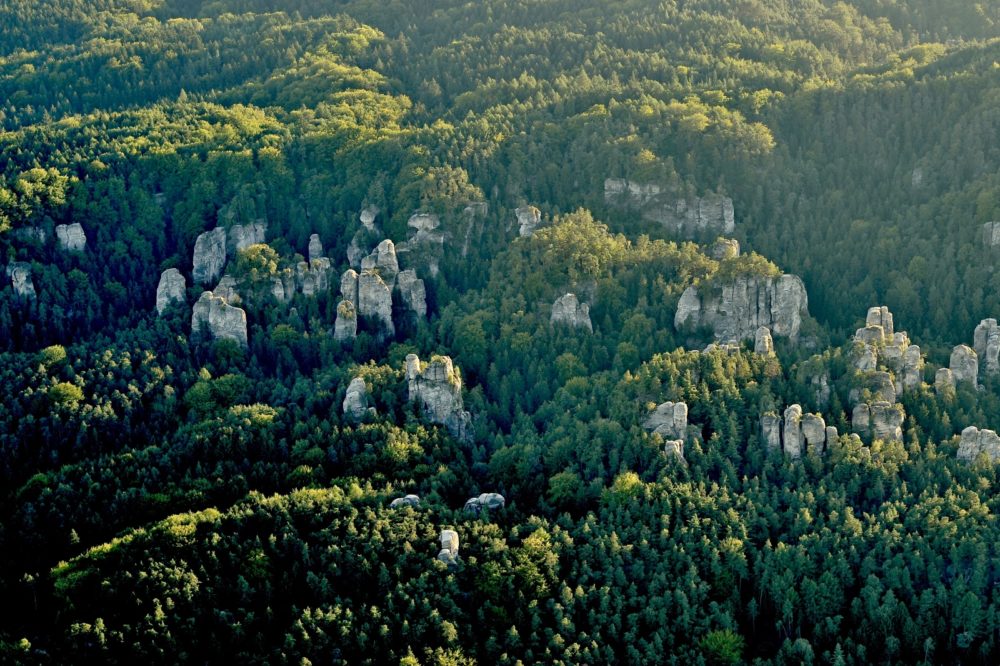 Photo: Aerial photo of the “Rock town” (“Skalní město”) on “Čertova ruka” in Český ráj, the phyloanalytically examined peat bog Maják lies just beyond the right edge of the photo; author P. Pokorný
Photo: Aerial photo of the “Rock town” (“Skalní město”) on “Čertova ruka” in Český ráj, the phyloanalytically examined peat bog Maják lies just beyond the right edge of the photo; author P. Pokorný
There are four records of prehistoric and medieval finds of pollen grains and larch phytoliths. These records are located in the most exposed parts of the sandstone relief. One record is on the edge of the Elbe canyon. Another record is directly in the rock wall in a very exposed part of the Rock town (Skalní město) in the western edge of the Bohemian Switzerland. The third record is in the Hruboskalské skalní město of the Český ráj area. The fourth record is on the edge of the rocky area near the Mužský site.
The records of discoveries mentioned here include the crucial time period of the mid-Holocene, which is known as the mid/late Holocene bottleneck by scientists. This era is particularly important for assessing the origin of European larch based on paleobotanical data, determining whether it occurred naturally or is a product of “old age”.
Scientists have discovered clear and definitive evidence of the continuous occurrence of a supposedly non-native tree species in northern Bohemia during the Holocene period. However, it is still unclear whether these relict populations had any impact on the genetic diversity of present-day populations.
For a while, due to the still inadequate state of research, scientists unequivocally refrain from commenting on any North Bohemian sandstone areas other than the two mentioned, České Švýcarsko and Český ráj.
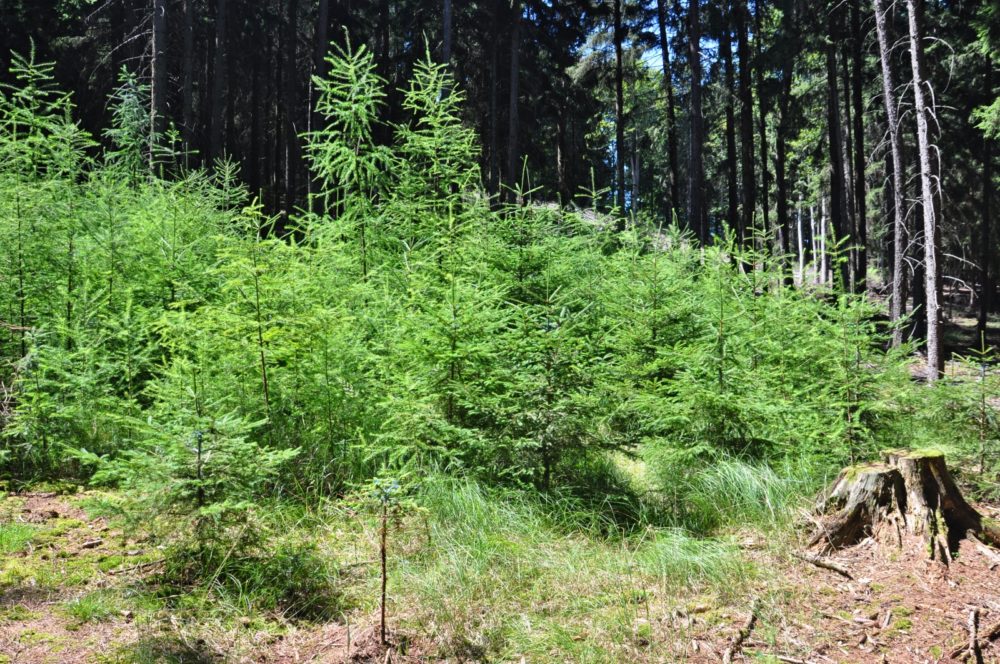 Photo: Natural regeneration of European larch, author Jan Řezáč
Photo: Natural regeneration of European larch, author Jan Řezáč
At the end of their paper, the scientists indicate what their findings can mean for practice, for the gradual convergence of forestry practice and nature conservation practice.
(1)
At least somewhere in the Czech landscape, larch was present in vegetation and climatic conditions similar to the present.
Although in small quantities, it is certainly a good argument for foresters who are willing to grow high-quality larch wood even where commercial forests overlap, for example, with buffer zones of nature conservation areas.
It is an objective point of view for managers and forest owners who want to have larch represented in the species composition of forest stands.
Occurrence of larch can be especially in the form of admixed (in the form of individual or group mixing), or even only as interspersed tree species, even, as mentioned, in economic forests within the second and third (and of course the fourth) zones of protected landscape areas.
Based on research, it has been concluded that there is no significant risk of uncontrolled spread of the European larch, even if it is grown as a non-native species. This is because historical evidence shows that larch tree species did not spread uncontrollably during prehistoric and medieval times, which is a clear indication of their non-invasive nature and the absence of any threat to other tree species.
The management of larch trees mixed with other species in commercial forests is not comparable to the management of non-native species like Douglas-fir, red oak, and Scots pine. Unlike these species, European larch is native to the Czech Republic.
(2)
Before the modern era, larch trees were not commonly found in Czech forests. New evidence presented in this paper has shown that larch grew in specific exposed areas of the North Bohemian sandstone regions in the ancient past. Therefore, it was not a significant component of the forests as it is today.
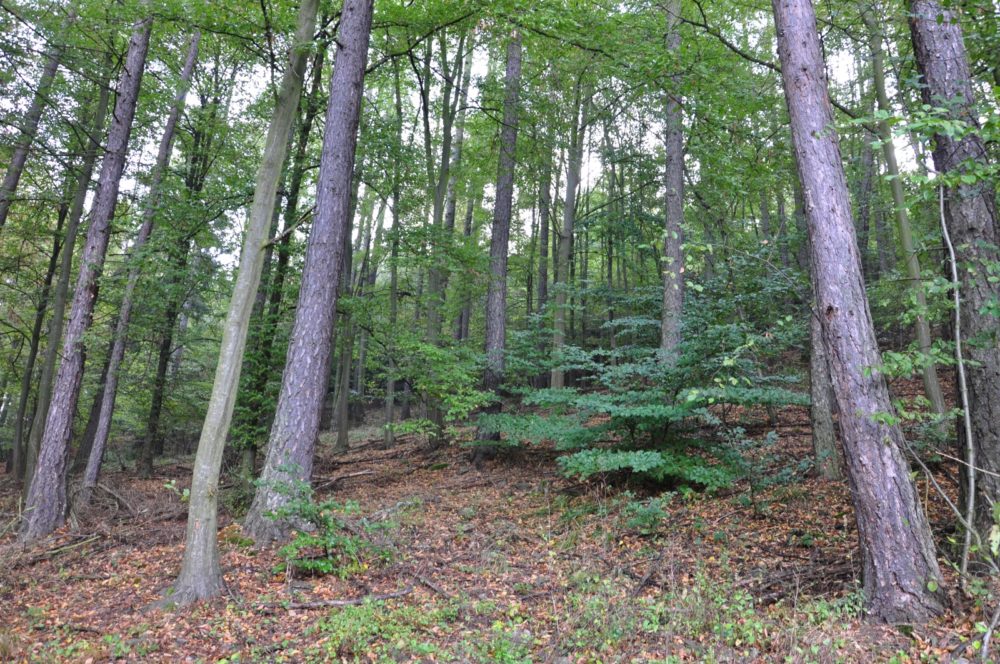 Photo: Interspersed European larch in a distinctly mixed forest, author Jan Řezáč
Photo: Interspersed European larch in a distinctly mixed forest, author Jan Řezáč
However, there is no reason to limit it (e.g., legislatively) in commercial forests outside protected areas. But also, based on the presented findings, it is impossible to support the unlimited cultivation of larch everywhere.
The discovery of the natural origin of larch in the Czech Republic is of great importance. But, it does not justify its further introduction into protected areas, such as nature reserves, and the first zones of PLA (CHKO) and NP (národní parky). This is particularly important in richer habitats where larch is not naturally present in the original habitat of the relevant tree species composition. In these mentioned cases, the primary goal is to restore and protect a state closer to nature, preserve the species composition, and maintain the structure of forest ecosystems.
Sometimes, in management plans for protected areas, we encounter two opposing views. One view is that the complete elimination of all non-native species, including larch, is necessary. The other view is that no action should be taken to remove larch. However, both of these views are extreme and not entirely suitable. We need to consider a balanced approach that takes into account the benefits and drawbacks of different actions.
Instead of focusing on areas where larch trees are commonly found, we should pay more attention to places where they are found in extreme habitats. Ideally, they should only be individually mixed in old stands or form less malleable to malleable groups. It is particularly important to look for such areas in historically complex timber-accessible localities that are separated and relatively far from obvious larch plantings.
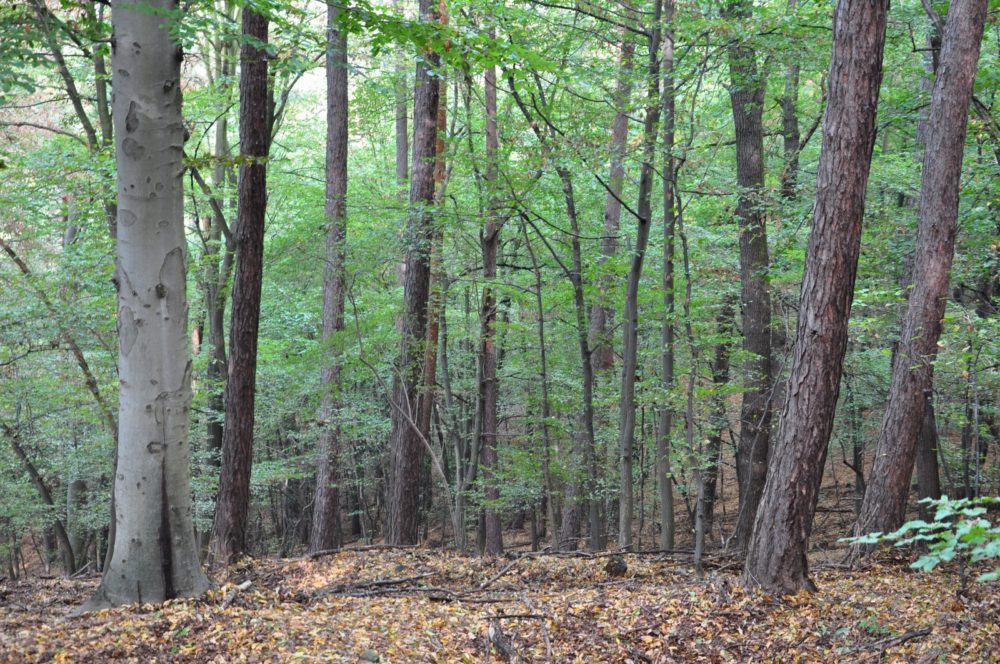 Photo: Interspersed European larch in a distinctly mixed forest, author Jan Řezáč
Photo: Interspersed European larch in a distinctly mixed forest, author Jan Řezáč
Certain locations may contain remnants of indigenous populations, which should be conserved for their historical value and the preservation of the local ecosystem. Additionally, these habitats may store a gene pool that is well-suited to the area’s specific conditions, which could have economic benefits.
It is important to preserve the uniqueness of potentially interesting and valuable local larch populations. To achieve this, they should not be “diluted” by planting larches from other origins in their surroundings, which would cause them to gradually lose their uniqueness. Instead, their natural regeneration should be supported, and if they need to be regenerated artificially, only seeds from the given local larch populations should be used.
However, the discovery of such possible places and populations remains the task of further targeted and detailed research, both of paleoecological and molecular genetic character. Hopefully, it will be possible before any original occurrences of larch disappear, either through ill-advised forestry measures, for example planting larch from elsewhere, or ill-advised conservation interventions calling for its strict and complete eradication.
The paper “New paleobotanical data prove the native status of European larch in North Bohemia“/„Nová paleobotanická data prokazují původní status modřínu opadavého v severních Čechách“/ can be downloaded here.
According to the original, prepared by: Ing. Jan Řezáč, VÚLHM, v. v. i., e-mail: rezac@vulhm.cz
